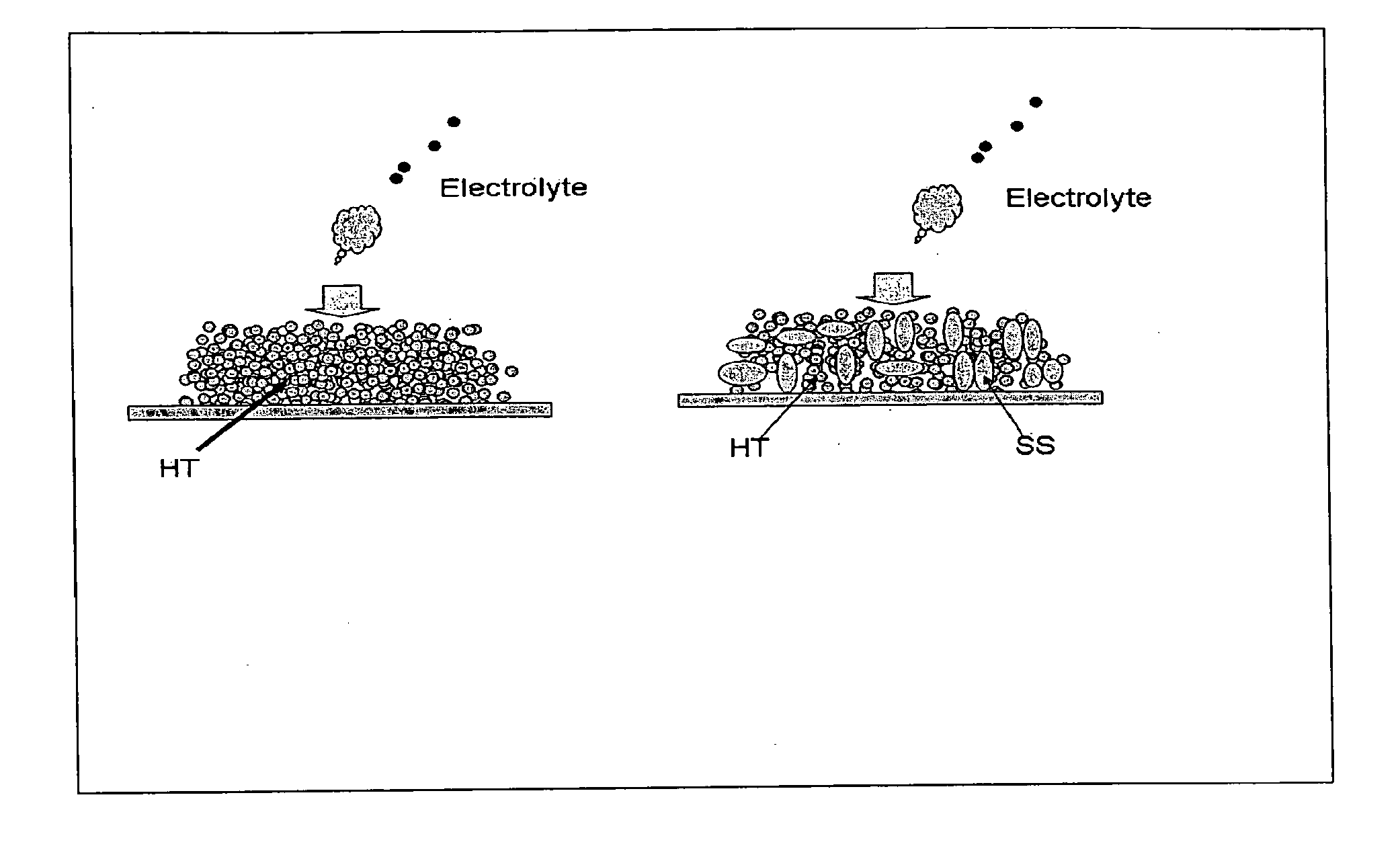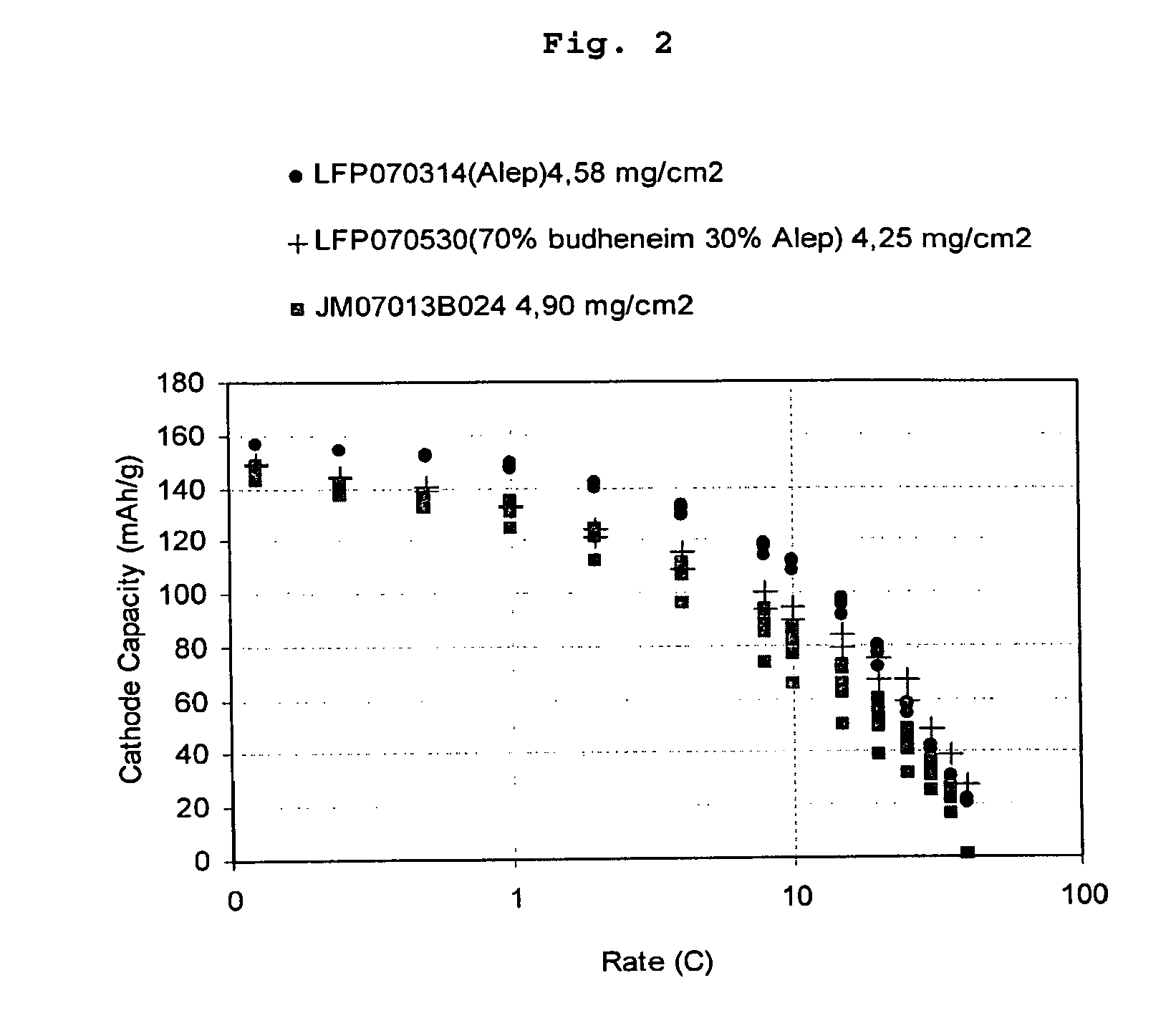Lithium Iron Phosphate Cathode Materials With Enhanced Energy Density And Power Performance
a technology of cathode materials and lithium iron phosphate, which is applied in the direction of electrical equipment, cell components, coatings, etc., can solve the problems of low electronic conductivity, slow electrode kinetics, and difficulty in achieving compact, high energy density and high power batteries, and achieve the effect of power performance and high discharge rate improvemen
- Summary
- Abstract
- Description
- Claims
- Application Information
AI Technical Summary
Benefits of technology
Problems solved by technology
Method used
Image
Examples
example 1
[0120]A bimodal LiFePO4 material comprising fine particles and coarse particles was synthesized by a solid state sintering process as described in WO0227823 and U.S. Pat. No. 7,285,260.
[0121]In summary, a first FePO4.2H2O precursor received from Bundenheim was jet milled to obtain micron sized particles with D50 of 2.3 microns.
[0122]70 wt. % of this jet milled Budenheim iron phosphate was mixed with 30 wt. % of a submicron sized iron phosphate (ALEP) made by controlled precipitation of an iron chloride precursor and phosphoric acid. To this mixture were added an adequate amount of lithium carbonate sold by Limtech and Unithox® polymer (as the carbon precursor) dissolved in IPA. The resulting mixture was homogeneized by ball milling using ceramic beads for 24 hours. The slurry was dried by using dry air.
[0123]Sintering synthesis is performed in a rotary kiln using a stainless steel reactor under the protection of a N2 flow. The powder was heated to 710° C. at a heating rate of 6° C. / ...
example 2
[0128]FePO4.2H2O from Bundenheim was jet milled to obtain micron sized particles with D50 of 2.3 microns.
[0129]70 wt. % of mixture comprising the jet milled Budenheim iron phosphate precursor and lithium carbonate and 30% of LiFePO4 made by a precipitation-hydrothermal process was mixed with 5% Unithox® polymer in IPA solution using a ball mill and ceramic beads. The obtained slurry was dried using dry air.
[0130]The sintering synthesis was performed on a rotary kiln as described in example 1. The packing density was measured using the sample method as described in example 1. Results in Table 2 show a packing density for the mixture higher than that for the pure components.
example 3
[0131]LiFePO4 made by a molten process is ground from the ingot to mm size particles by jaw crusher and roller. Part of these mm size particles are fed in a Jet mill and ground to micron size particles, and part of the mm size particles are ground to submicron size particles. These two particle products are mixed together mechanically to optimize packing density. Results are shown in Table 3 and FIG. 3. Similar results are found when micron size particles and submicrosize particles are prepared from molten LiMnPO4 and mixed together.
PUM
| Property | Measurement | Unit |
|---|---|---|
| volume fraction | aaaaa | aaaaa |
| volume fraction | aaaaa | aaaaa |
| thickness | aaaaa | aaaaa |
Abstract
Description
Claims
Application Information
 Login to View More
Login to View More - R&D
- Intellectual Property
- Life Sciences
- Materials
- Tech Scout
- Unparalleled Data Quality
- Higher Quality Content
- 60% Fewer Hallucinations
Browse by: Latest US Patents, China's latest patents, Technical Efficacy Thesaurus, Application Domain, Technology Topic, Popular Technical Reports.
© 2025 PatSnap. All rights reserved.Legal|Privacy policy|Modern Slavery Act Transparency Statement|Sitemap|About US| Contact US: help@patsnap.com



